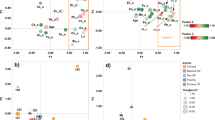Summary
Behavioral, renal, hepatic and pulmonary tests were applied to 22 subjects exposed to tetrachloroethylene in 6 dry-cleaning shops. The results were compared with those obtained in 33 subjects non-occupationally exposed to organic solvents. The intensity of exposure was monitored by personal environmental monitoring and by urine analysis for trichloroacetic acid and expired air and venous blood analysis for tetrachloroethylene. The time-weighted average exposure to tetrachloroethylene amounted to 21 ppm (range 9 to 38 ppm). The correlation between the concentration of tetrachloroethylene in ambient air sampled with the charcoal tube method and with a passive dosimeter indicates that the latter can correctly estimate the time-weighted average exposure to the solvent. In view of the long biological half-life of tetrachloroethylene, the internal dose may be better estimated by measuring its concentration in blood 16 h after the end of exposure (i.e. before resuming work the next morning). The present study suggests that if the blood concentration of tetrachloroethylene does not exceed 1 mg/1,16 h after the end of exposure, the time-weighted average exposure is likely to have been below 50 ppm. Exposure to such level for 6 years on the average does not seem to exert any adverse effect on the central nervous system, the liver and the kidney.
Similar content being viewed by others
References
ACGIH (American Conference of Governmental Industrial Hygienists) (1982) Threshold limit values for chemical substances and physical agents in the work environment with intended changes for 1982. Cincinnati, OH, USA
Bernard A, Vyskocil A, Lauwerys R (1981) Determination β 2-microglobulin in human urine and serum by latex immunoassay. Clin Chem 27:382–387
Bernard A, Moreau D, Lauwerys R (1982) Latex immunoassay of retinol-binding protein. Clin Chem 28:1167–1171
Bernard A, Lauwerys R (1983) Latex immunoassay of urinary albumin. J Clin Chem Clin Biochem 21:25–30
Bolt HM, Laib RJ, Filser JG (1982) Commentary. Reactive metabolites and carcinogenicity of halogenated ethylenes. Biochem Pharmacol 31:14
Bonse G, Henschler H (1976) Chemical reactivity, biotransformation and toxicity of polychlorinated aliphatic compounds. CRC Crit Rec Toxicol 4:395–409
Buchet JP, Lauwerys R, Roels H (1974) Le dosage par chromatographie en phase gazeuse des métabolites urinaires du trichloréthylène: l'acide trichloroacétique et le trichloroéthanol. Arch Mal Prof 35:395–402
Carpenter CP (1937) The chronic toxicity of tetrachloroethylene. J Ind Hyg Toxicol 19:323–336
Cerna M, Kypenova H (1977) Mutagenic activity of chloroethylenes analysed by screening system tests. Mutat Res 46:214–215
Cherniak RM (1977) Pulmonary function testing. Saunders, Philadelphia
Coler HR, Rossmiller HR (1953) Tetrachloroethylene exposure in a small industry. Ind Hyg Occup Med 8:227
Deutsche Forschungsgemeinschaft (1982) Maximum concentrations at the workplace 1982. Commission for Investigation of Health Hazards of Chemical Compounds in the Work Area. Boldt Verlag, 5407 Boppard, FRG
Fernandez J, Guberan E, Caperos J (1976) Experimental human exposures to tetrachloroethylene vapor and elimination in breath after inhalation. Am Ind Hyg Assoc J 37:143
Greim H, Bonse G, Radwan Z, Reichert D, Henschler D (1975) Mutagenicity in vitro and potential carcinogenicity of chlorinated ethylenes as a function of metabolic oxirane formation. Biochem Pharmacol 24:2013–2017
Ikeda M, Koizumi A, Watanabe T, Endo A, Sato K (1980) Cytogenetic and cytokinetic investigations on lymphocytes from workers occupationally exposed to tetrachloroethylene. Toxicol Lett 5:251–256
Lauwerys R (1983) Industrial chemical exposure: guidelines for biological monitoring. Biomedical Publications. Davis, California
Meckler LC, Phelps DK (1966) Liver disease secondary to tetrachloroethylene exposure. J Am Med Assoc 197:144–145
Monster AC, Boersma C, Steenweg H (1976) Kinetics of tetrachloroethylene in volunteers: influence of exposure concentration and work load. Int Arch Occup Environ Health 42:303
NIOSH (1978a) Manual of analytical methods, vol 4. Cincinnati, Ohio, USA
NIOSH (1978b) Current intelligence bulletin 20: Tetrachloroethylene (perchloroethylene). DHEW Publication, pp 78–112
Ogata M, Takatsuka Y, Tomokuni K (1971) Excretion of organic chloride compounds in the urine of persons exposed to vapours of trichloroethylene and tetrachloroethylene. Br J Ind Med 28:386–391
Pedersen LM, Nygaard E, Nielsen OS, Saltin B (1980) Solvent-induced occupational myopathy. J Occup Med 22:603–606
Rowe VK, McCollister DD, Spencer HC, Adams EM, Irish DD (1952) Vapor toxicity of tetrachloroethylene for laboratory animals and human subjects. Arch Ind Hyg Occup Med 5:566–579
Schumann AM, Quast JF, Watanabe PG (1980) The pharmacokinetics and macromolecular interactions of perchloroethylene in mice and rats as related to oncogenicity. Toxicol Appl Pharmacol 55:207
Schwetz BA, Leong BKJ, Gehring PJ (1975) The effect of maternally inhaled trichloroethylene, perchloroethylene, methylchloroform, and methylene chloride on embryonal and fetal development in mice and rats. Toxicol Appl Pharmacol 32:84–96
Stewart RD, Dodd HC (1964) Absorption of carbon tetrachloride, trichloroethylene, tetrachloroethylene, methylene chloride and 1,1,1 trichloroethane through the human skin. Am Ind Hyg Assoc J 25:439
Stewart RD, Baretta ED, Dodd HC, Torkelson TR (1970) Experimental human exposure to tetrachloroethylene. Arch Environ Health 20:224–229
Stewart RD, Hake CL, Wu A, Kalbfleisch J, Newton E, Marlow SK, Vuciecevic-Salama M (1977) Effect of perchloroethylene/drug interaction on behavior and neurological function. NIOSH Technical Information. US Department of Health, Education and Welfare. National Institute for Occupational Safety and Health. Cincinnati, Ohio, USA
Author information
Authors and Affiliations
Additional information
This study was supported by a grant from the Fonds de la Recherche Scientifique Médicale, Belgium
Rights and permissions
About this article
Cite this article
Lauwerys, R., Herbrand, J., Buchet, J.P. et al. Health surveillance of workers exposed to tetrachloroethylene in dry-cleaning shops. Int Arch Occup Environ Health 52, 69–77 (1983). https://doi.org/10.1007/BF00380609
Received:
Accepted:
Issue Date:
DOI: https://doi.org/10.1007/BF00380609




